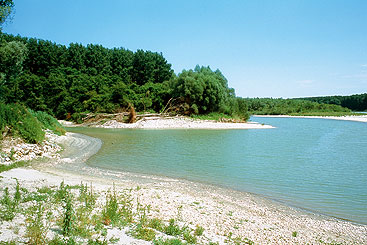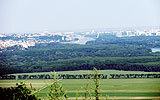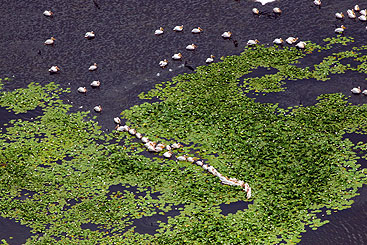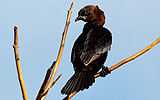The Danube River – Europe’s backbone of biodiversity

The Danube River –
Europe’s backbone
of biodiversity
The richness in habitats, flora and fauna qualifies the Danube River to be a focus for conservation of biodiversity in Central and South-East Europe. Experts from different Protected Areas weigh in on the wise use of this natural heritage.

River dynamics provide the basis for a wide range of river habitats and secure long-term richness in biodiversity.
The Danube is the major river of Europe, connecting Central Europe to the South-Eastern parts. Because of its large area and very diverse habitats – gravel islands on the Upper River, large remaining forest floodplains, extended wetlands on the Lower River – it provides suitable living conditions for a large number of different species. The complete river basin, including tributaries, is home to around 2,000 plant and 5,000 animal species, including numerous endangered or nearly extinct species. However, our knowledge of the richness of biodiversity and the complexity in ecosystems is only beginning.
Diversity in peril. Diversity along the river is threatened: Many dynamic habitats have nearly disappeared due to river engineering, hydropower plants and navigation projects. Growing cities have made flood protection measures necessary, which in turn cut off large floodplain areas from the river system. For these and many other reasons, the extinction rate of species is currently around 1,000 times faster than it should be. Mammals are especially threatened - 1% of the nearly 6000 species worldwide is extinct, with another 22% endangered in varying degrees. The group of animals under highest pressure are amphibians, with 30% of species threatened.
However, considering that biodiversity gives mankind a variety of goods and services - which are now starting to be valued also in terms of money – the United Nations declared 2010 to be the International Year of Biodiversity as a “celebration of life on earth and of the value of biodiversity for our lives”.

Danube Protected Areas play a key role for the conservation of biodiversity.
Protected Areas – hotspots of biodiversity. This year the Danube Delta Biosphere Reserve celebrates its 20th anniversary. Established in 1990, it is not only one of the first protected areas in the Danube River Basin, it is also one of the largest (580,000 hectares) and richest in biodiversity.
“The Danube Delta is a natural gene bank with inestimable value for the world‘s natural heritage”, says Governor Grigore Baboianu proudly. “The mosaic of habitats developed here is the most various in Romania, hosting a great variety of communities of plants and animals that number around 5,429.” In 30 types of habitats, the area is home to 1,839 flora species, 678 algae species and 1,016 cormophytes. The 3,590 fauna species include 2,244 species of insects, 91 species of molluscs, 135 fish species and 331 different bird species.
Conservation programmes for flagship species. With limited resources available for nature protection and poor knowledge of the habitat requirements of most of the species, it is not possible for protected areas to run conservation programmes for all endangered species, but instead it is necessary to focus on ‘flagship species’.
“Concrete conservation actions for flagship species for the Danube islands also support other characteristic species here in Persina Nature Park”, says Director Stela Bozhinova of one of the conservation strategies for this Bulgarian Protected Area. “In the long term, our conservation activities for the Pygmy cormorant – a globally threatened bird species – will be beneficial not just for this species. The activities implemented in the frame of a cross-border LIFE+ project should improve habitat conditions for a wide range of other organisms.”
Habitat management for biodiversity. Our philosophy of conservation of species is based on conservation of their natural habitats”, explains Tomas Kusik, biodiversity expert of the Slovakian DANUBEPARKS partner BROZ. “Therefore, we prefer long-term management of selected areas“, adds his colleague Mira Ruda. In the Slovakian Danube Floodplains, BROZ has re-established meadow grazing by cows, horses and sheep, which was a common land use on Danube islands many decades ago. The vegetation, including numerous endangered plants, insects and other organisms, is still adapted to this way of management and will benefit significantly.
Tibor Parrag, head of the department for nature conservation in the Duna-Dráva National Park, stresses an additional concern. “The negative effects of human activities influence most types of habitats and therefore, there is the need for habitat restoration. In the long term we are trying to restore ‘self-regulated habitats’ which won’t need permanent human management in the future.” In addition to day to day conservation management for selected habitat types and hotspots for some priority species, nature conservation increasingly focuses on the initiation, the restoration and the conservation of natural processes.

Developing the Danube River as a biological corridor is important for the long-term conservation of biodiversity. However, green corridors between big cities could also bring a wide range of benefits for people.
Conservation of natural processes. The incredible biodiversity in floodplains is based on the wide range of different habitats developed by the permanent change of parameters of the water regime. Furthermore, highly dynamic river habitats like gravel banks and sandy islands are some of the most endangered ecosystems. Therefore, nature protection on a river has to be based on river dynamics.
Even the best human habitat management will not be able to compensate for the loss of river dynamics – ecological river engineers prefer just to initiate and then “let the river do the work”. “The river restoration projects here in our Protected Area initiate and bring back the dynamic of the river”, says Carl Manzano, Director of the Donau-Auen National Park, located between Vienna and Bratislava. “This is the only guarantee for the existence and permanent redevelopment of characteristic habitats for the long term.”
The compensation of dynamic habitats by artificial structures has been tried several times and can work for specific species. But observations on the behaviour of the Little-ringed Plover on the Austrian section of the Danube – a characteristic breeding bird species on gravel islands in this part of the Danube – has brought interesting results: compared to gravel islands created by natural river dynamics, birds have to invest much more time in foraging on artificial islands when they are ‘established’ by human activities. “Obviously, the number of available foods on natural habitats – including a wide range of insects, spiders etc. – is much higher in natural habitats”, explains Matthias Schmidt, conservation officer of BirdLife Austria.
Similar cases can be found in forests, where the very specific requirements of dead wood beetles underline the need for forest dynamics for the conservation of species, showing that it is hardly possible to compensate for dynamic habitats and the richness of biodiversity.

Conservation activities for flagship species - like the Pygmy Cormorant - contribute to improved habitat quality for numerous organisms.
Habitat networks for biological corridors. The efforts of Protected Areas alone cannot ensure long-term conservation of all the characteristic animal and plant species of the region. Most Protected Areas, at less than 1,000 hectares) cover small areas in comparison to the total territory. The White-tailed Eagle, - one of the flagship species for the protection of large scale floodplain habitat complexes - inhabits home ranges up to some thousand hectares. Protected Areas can only act as key habitats and stepping stones for such endangered species.
But rivers can serve as biological corridors, such as for Danube sturgeons migrating from the Black Sea upstream to their spawning areas in the Upper Danube region. The EU Water Framework Directive, as well as the Danube River Basin Management Plan, highlights the importance of the corridor function of rivers and longitudinal continuity.
For biodiversity, the longitudinal continuity of a river should include more than just fish ladders and bypasses for hydro power dams, it must also has take into consideration semi-aquatic and terrestrial habitats. To ensure re-colonisation, specific habitats have to be connected with source populations by suitable stepping stones. So the protection of specific habitat structures like gravel islands, steep dynamic river banks or gallery forests in Protected Areas can conserve sustainable populations of characteristic species only if we protect source populations and if we develop a coherent habitat network including numerous stepping stones along the whole river section.
A transnational strategy for biodiversity. The elaboration of the EU Strategy for
the Danube region is going into the final
phase. At this stage, in addition to the
improvement of connectivity and communication
systems and the reinforcement of
the socio-economic development, the preservation
of the environment – including
the conservation of biodiversity – has been
identified as one of the main pillars for this
strategy.
The inspiration of a living river – including
all flora and fauna, the richness in habitats
and structures as well as human culture linked to nature –integrates Central and South-East
Europe. Implementing corridor concepts will emerge as
the key role of Protected Areas for the conservation of
these natural values. DANUBEPARKS – The Danube
River Network of Protected Areas was established in
2009 to start facing these challenges on the field of
nature conservation.
The EU Strategy for the Danube Region is expected to underline the importance of transnational activities for biodiversity conservation and to strengthen transnational initiatives to raise the capacity of key actors. In this way, the EU Strategy for the Danube Region could significantly contribute to establishing the role of the Danube River as a living corridor and the backbone for biodiversity in Central and South-East Europe.
For more information, please visit: www.danubeparks.org.





